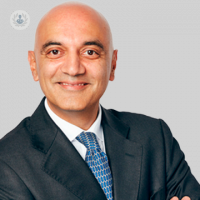Overactive bladder in women: Ask an expert
Written by:Having an overactive bladder is not easy. However, it is a problem that many women have to deal with. How do we define an overactive bladder? What causes it and how can it be treated? Leading gynaecologist Mr Arvind Vashisht explains.

What is an overactive bladder?
An overactive bladder is a relatively common condition that can produce the following symptoms:
- Frequency – going to the toilet more than usual
- Nocturia – getting up at night to pass urine
- Urgency – a desperate need to urinate
- Urge incontinence – not being able to make it to the toilet in time
Many women will battle on with overactive bladder symptoms for some time before they seek help. Many women may be embarrassed or feel that there are no treatments and therefore delay seeking help. In fact, for many women, relatively simple interventions can lead to significant improvements. For some women investigations such as a urodynamics test can help evaluate bladder function and guide successful treatments. These tests can help distinguish an overactive bladder from other common bladder conditions such as stress incontinence (when urine is lost involuntarily on exertional activities such as coughing, running or sneezing).
What causes an overactive bladder?
Normally, the bladder gradually fills with urine which is produced from the kidneys. As it fills, it expands rather like a balloon. The stretching and expanding bladder muscles trigger signals sent to the brain, letting it know that the bladder is filling up. The fuller the bladder gets, the stronger the signals, and the more desperate we feel that we need to empty the bladder. This sensation is relieved when we urinate: rather than continuing to stretch further, the bladder muscle is allowed to squeeze or contract, and urine flows out (urination).
When a person has an overactive bladder, it squeezes at inappropriate times, often when the bladder is nowhere near full and does not need to be emptied. This squeezing causes an unpleasant feeling of urgency and can even be strong enough to force urine out at unintended times, causing leakage or incontinence.
How do you treat an overactive bladder?
Lifestyle measures are the first point of treatment and are important in helping women to manage an overactive bladder.
- Reduce excessive fluid intake
- Avoid caffeine (e.g. coffee, tea, etc.)
- Avoid alcohol
- Losing weight
Pelvic floor exercises and bladder retraining can also help the patient to control their symptoms. In my practice, we have a team of nurse specialists and physiotherapists who can help with this.
In many cases, the doctor will recommend combining these measures with medical treatments. There are a variety of drugs available that may help keep an overactive bladder under control. However, they can also cause some side-effects, particularly at the start of the treatment, but these may subside over time. Constipation and a dry mouth are common examples. Different medications work best for different women, so some cases may require trialling different preparations to find the most appropriate. There are specific medications that may treat particular women well, and your doctor is likely to help choose the most appropriate one.
If lifestyle measures and medication fail to make a difference, there are also surgical options for overactive bladder. These include:
- Botox injections into the bladder
- Sacral neuromodulation - an electrode device is implanted to help control nerve signals coming to and from the bladder.
These specialised treatments for overactive bladder will be discussed with you by your doctor. For some women, the above surgical choices can dramatically improve their daily activities. Again, to choose these, it makes sense to have worked through a careful treatment regime for overactive bladder first, considered alternatives and to judge how much your symptoms are impacting on your quality of life.
If you are having problems with an overactive bladder, book an appointment with Mr Vashisht via his Top Doctors profile.


